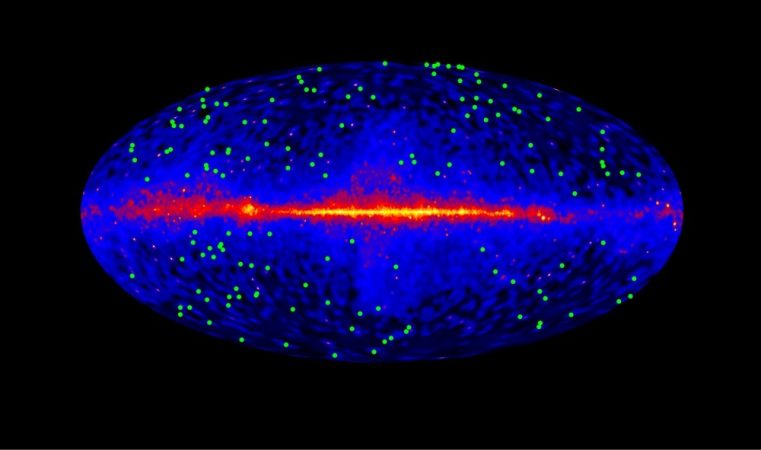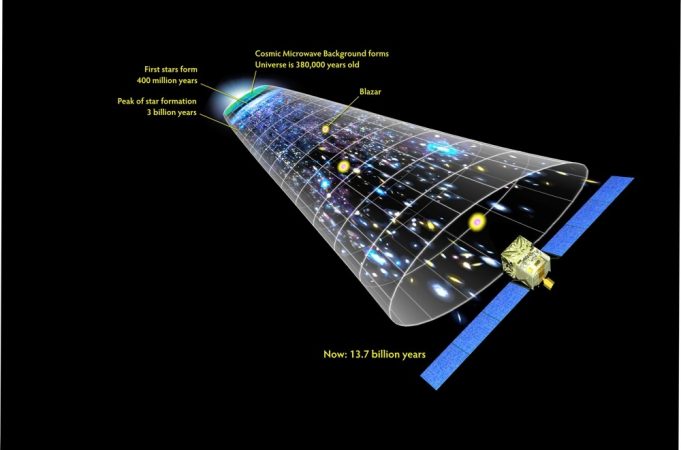Twinkle, twinkle oldest stars
Astronomers find traces of ancient light in the activity of bright, distant galaxies
Share this:
- Share via email (Opens in new window) Email
- Click to share on Facebook (Opens in new window) Facebook
- Click to share on X (Opens in new window) X
- Click to share on Pinterest (Opens in new window) Pinterest
- Click to share on Reddit (Opens in new window) Reddit
- Share to Google Classroom (Opens in new window) Google Classroom
- Click to print (Opens in new window) Print

Call it the “cosmic fog.” Or the “extragalactic background light.” Astronomers use these names to describe the light that has left every star and now lingers in the universe, including light from stars that have burned out. Studying this background light can be tricky because objects that produce or reflect light — stars, galaxies, dust, bright stuff hurled through space by a black hole — can get in the way. But, astronomers have just determined how super-bright galaxies can be used to detect the faint glow of the cosmic fog.
A galaxy is a group of millions or billions of stars held close together by gravity. The new light-detection technique will allow scientists to spot light from all stars from all times.
“[This way of looking] provides us with a review of the entire history of cosmic star formation, including the very first epochs of star formation in the very early universe,” says Volker Bromm of the University of Texas at Austin. This astronomer, who did not work on the new study, spoke with Science News.
Astronomers believe an event called the Big Bang formed the universe about 13.7 billion years ago. The first stars are thought to have lit up when the universe was just an infant — about 400 million years old. Light from those early stars is too faint to be seen directly.
“Detecting these stars is very important but currently impossible,” astronomer Marco Ajello, of the Kavli Institute for Particle Astrophysics and Cosmology at Stanford, told Science News. Ajello worked with more than 100 other scientists on the new study. It was published in the Nov. 2 Science.
Researchers had to develop an indirect way to measure the light from the first stars. Imagine looking through a window on a rainy day: It’s hard to see individual raindrops on their way down. But if you look at the ground, you can see that it’s wet. And if you glance at a puddle, you can see waves radiating out from where the raindrops hit. Those waves and the wet ground are indirect evidence of the rain
To find the old light, astronomers looked at blazars. These are faraway but super-bright galaxies that, like most galaxies, are held together by the gravitational attraction of all of their many stars. A black hole is a spot in space with an intensely powerful gravitational attraction. Black holes don’t only pull things in — they can also send out powerful jets of radiation called gamma rays. If that gamma-ray jet happens to be pointing directly at Earth, the galaxy is called a blazar.

Light travels as tiny particles called photons. When photons smash into the blazar’s gamma rays, the collision dims the light from the blazar. NASA’s Fermi Large Area Telescope can detect gamma rays — and that dimming from the faraway galaxies.
Astronomers used data collected by that telescope to map the collisions. Blazars are spread out across the sky, so scientists can use them to measure the cosmic fog in different areas. In the new study, Ajello and his many collaborators studied 150 blazars. They found leftover light from when the galaxy was only 4 billion years old. And the researchers are just getting started: Their team will begin probing for light from even older stars.
Those pioneering stars, Ajello says, were probably different from modern stars like the sun. “The first stars were in general more massive — up to hundreds of times as massive as the sun — hotter, brighter and more short-lived.”
Power Words
black hole A region in space with a powerful gravitational attraction.
blazar A bright and distant active galaxy that shoots powerful jets of radiation from its center and directly toward Earth.
galaxy A system of millions of billions of stars that move through space together, held together by gravity.
gravity The force that attracts any body with mass toward any other body with mass. The more mass there is, the more gravity there is.
gamma ray Electromagnetic radiation with shorter wavelengths — and therefore more energy — than X-rays.
photon A particle representing the smallest possible amount of light or other electromagnetic radiation.
cosmology The science of the origin and development of the universe.
Big Bang A single violent event that is believed to mark the origin of the universe.
electromagnetic radiation Radiation that includes visible light, radio waves, gamma rays, and X-rays, in which electric and magnetic fields vary simultaneously.






